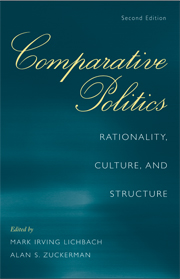Book contents
- Frontmatter
- Contents
- Contributors
- Preface and Acknowledgments
- 1 PARADIGMS AND PRAGMATISM
- 2 THINKING AND WORKING IN THE MIDST OF THINGS
- 3 ADVANCING EXPLANATION IN COMPARATIVE POLITICS
- 4 STRONG THEORY, COMPLEX HISTORY
- 5 RECONSIDERATIONS OF RATIONAL CHOICE IN COMPARATIVE AND HISTORICAL ANALYSIS
- 6 CULTURE IN COMPARATIVE POLITICAL ANALYSIS
- 7 RESEARCHING THE STATE
- 8 AN APPROACH TO COMPARATIVE ANALYSIS OR A SUBFIELD WITHIN A SUBFIELD?
- 9 THE GLOBAL CONTEXT OF COMPARATIVE POLITICS
- 10 COMPARATIVE PERSPECTIVES ON CONTENTIOUS POLITICS
- 11 CITIZENSHIP IN DEMOCRATIC POLITICS
- 12 NESTED CITIZENS
- 13 BACK TO THE FUTURE
- 14 THE COMPARATIVE POLITICAL ECONOMY OF THE WELFARE STATE
- 15 MAKING CAUSAL CLAIMS ABOUT THE EFFECT OF “ETHNICITY”
- References
- Author Index
- Subject Index
- Titles in the series
9 - THE GLOBAL CONTEXT OF COMPARATIVE POLITICS
Published online by Cambridge University Press: 05 June 2012
- Frontmatter
- Contents
- Contributors
- Preface and Acknowledgments
- 1 PARADIGMS AND PRAGMATISM
- 2 THINKING AND WORKING IN THE MIDST OF THINGS
- 3 ADVANCING EXPLANATION IN COMPARATIVE POLITICS
- 4 STRONG THEORY, COMPLEX HISTORY
- 5 RECONSIDERATIONS OF RATIONAL CHOICE IN COMPARATIVE AND HISTORICAL ANALYSIS
- 6 CULTURE IN COMPARATIVE POLITICAL ANALYSIS
- 7 RESEARCHING THE STATE
- 8 AN APPROACH TO COMPARATIVE ANALYSIS OR A SUBFIELD WITHIN A SUBFIELD?
- 9 THE GLOBAL CONTEXT OF COMPARATIVE POLITICS
- 10 COMPARATIVE PERSPECTIVES ON CONTENTIOUS POLITICS
- 11 CITIZENSHIP IN DEMOCRATIC POLITICS
- 12 NESTED CITIZENS
- 13 BACK TO THE FUTURE
- 14 THE COMPARATIVE POLITICAL ECONOMY OF THE WELFARE STATE
- 15 MAKING CAUSAL CLAIMS ABOUT THE EFFECT OF “ETHNICITY”
- References
- Author Index
- Subject Index
- Titles in the series
Summary
The literature on the international sources of domestic politics has an important pedigree in comparative politics in the works of Herz (1950), Gerschenkron (1962), Hintze (1975), Gourevitch (1978, 1986), Cameron (1978), Skocpol (1979, 1992), Bates (1981), Tilly (1985), Katzenstein (1985), Putnam (1988), Rogowski (1989), and world system and dependency theory, among others. Although, as Gourevitch (1996: 8) argued over a decade ago, “comparative politics have never been wholly autonomous from international influences,” the end of the Cold War marked an explosion in the study of internationalization, globalization, and their effects on domestic politics. This chapter addresses developments in this literature published since this volume's first edition.
The relationship between domestic and international politics entails two kinds of linkages (see Figure 9.1). The first are known as “second-image reversed” effects (Gourevitch 1978), referring to the impact of international forces on domestic politics, from the outside-in. Many among the intellectual forerunners in the study of domestic–international linkages cited earlier fall under this category. The second kind – “second-image” effects (Waltz 1954) – link domestic structures and institutions to international politics from the inside-out. These two types of effects intersect in the domestic realm, where a process of conversion takes place. States, political parties, social movements, peak associations, labor unions, policy networks, armed forces, and other collective and individual actors respond to “second-image reversed” effects – on the basis of rational incentives and normative tendencies – with preferences and policies that feed into “second-image” effects from the inside out.
- Type
- Chapter
- Information
- Comparative PoliticsRationality, Culture, and Structure, pp. 220 - 259Publisher: Cambridge University PressPrint publication year: 2009
- 4
- Cited by



